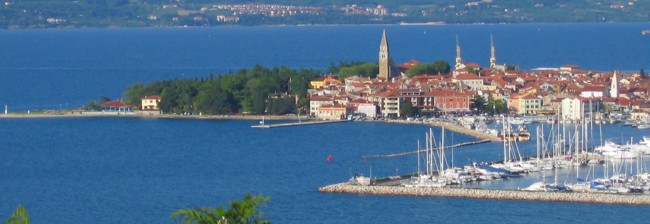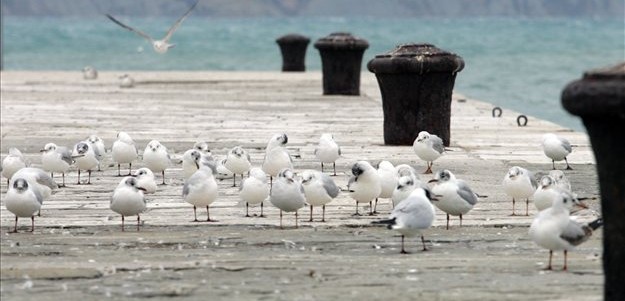
|
The
municipality of Izola is in the northwestern part of Istria
and is a part of the Koper Littoral. The territory has the
shape of a triangle, which borders the municipality of Koper
in the east, the municipality of Piran in the south and west,
and the sea in the north. It has a Meditteranean climate
with mild winters and hot summers.
The settlements of Izola are Baredi, Cetore, Dobrava, Izola,
Jagodje, Korte, Malija, Nožed and Šared . The municipality
is divided in 5 parts (Staro mesto, Haliaetum, Livade,
Jagodje-Dobrava, Korte). The highest point is the Malija
Hill.
Municipal festival is celebrated on 11 July, the day a large
number of men joined partisans.
The coat of arms has the shape of a shield and it represents
a flying dove with an olive branch in its beak (according to
legend) and in the background a blue sky and a yellow
semicircle, which symbolizes the island. The flag is blue
with the municipality’s coat of arms in the middle.
The name Izola in Italian (Isola) means an island. It
connected with the mainland around 1800.
 več
o Izoli več
o Izoli |

|
Izola ( pronunciation (help·info)) (Italian: Isola d'Istria)
is an old fishing city and a municipality in southwestern
Slovenia on the Adriatic coast of the Istrian peninsula. Its
name originates from the Italian Isola, which means island.
An ancient Roman port and settlement known as Haliaetum
stood to the southwest of the present town as early as the
2nd century BC. The town of Izola was established on a small
island by refugees from Aquileia in the 7th century . The
coastal areas of Istria came under Venetian influence in the
9th century. The settlement was first mentioned in writing
as Insula in a Venetian document entitled Liber albus in
932AD. It became definitely the territory of the Republic
of Venice in 1267, and the centuries of Venetian rule left a
strong and enduring mark on the region. The Venetian part of
the peninsula passed to the Holy Roman Empire of the German
Nation in 1797 with the Treaty of Campo Formio, until the
period of Napoleonic rule from 1805 to 1813 when Istria
became part of the Illyrian provinces of the Napoleonic
Empire. After this short period, during which Izola's walls
were torn down and used to fill in the channel that
separated the island from the mainland, the newly
established Austrian Empire ruled Istria until November
1918. Then Istria became part of the Kingdom of Italy,
until Italian capitulation in September 1943, whereupon
control passed to Germany. Izola was liberated by a naval
unit from Koper at the end of April 1945. After the end of
World War II, Izola was part of Zone B of the provisionally
independent Free Territory of Trieste; after the de facto
dissolution of the Free Territory in 1954 it was
incorporated into Slovenia, then a part of Yugoslavia. The newly defined Italo-Yugoslav border saw the migration of
many people from one side to the other. In Izola's case,
many Italian speakers chose to leave, and in their place
Slovenian-speaking people from neighbouring villages settled
in the town.
In 1820, a thermal spring was discovered in Izola, leading
to the town's earliest forms of tourism. Between 1902 and
1935 the Parenzana, a narrow-gauge railway line connected
the town to Trieste and Poreč (known as Parenzo until 1947).
Today Izola has many hotels near the sea, a famous
discotheque (Embassy of Gavioli) Ambasada Gavioli, many art
galleries, summer concerts, street performances and a movie
festival.
|
|